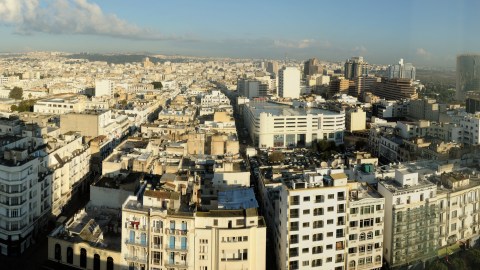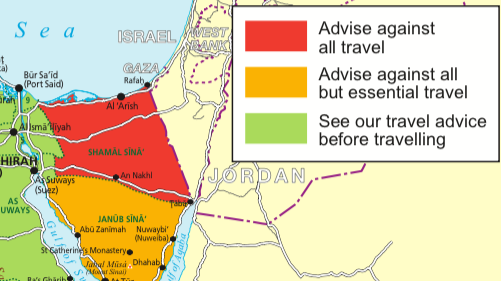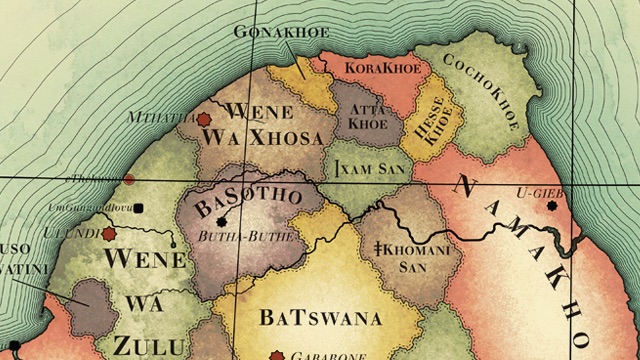How did Africa get its name?

Image: Hansueli Krapf, CC BY-SA 3.0
- “Africa” is just one of the ancient names that competed to define the entire continent.
- Geographical terms like Sudan, Maghreb, and Guinea have remarkably wide and changeable areas of application.
- Newly independent African nations sometimes adopted names of former kingdoms – even faraway ones.

The place-name pairs come in three categories: ancient, geographical and pre-colonial.
Vast and varied
The names of continents are so well-established that we forget how obscure their origins really are. America is named after an Italian explorer, but not the one historically credited with its discovery. Europe and Asia may derive from the Akkadian words for “sunset” and “sunrise,” but there are a host of other etymologies.
And, as these maps show, Africa is just one of the many names that have been used to describe this vast and varied land mass. The maps come in three categories – names of ancient, geographical and pre-colonial origin – and show the areas to which those names apply: dark, for the old version; and outlined, for the current one.

Libya, Ethiopia and Africa are all local names that at one time applied to the entire continent.
Ancient toponyms
- Libya is an ancient Greek toponym for the lands between the Nile and the Atlantic Ocean, and sometimes by extension for the entire continent. The name may derive from the local Libu tribe. Libya is also the name of the modern North African country between Tunisia and Egypt, formerly infamous for the violent surrealism of Colonel Ghadaffi’s decades-long dictatorship and currently for its lawlessness and low-intensity civil war.
- Ethiopia derives from the classical Greek for “burnt-face” (possibly in contrast to the lighter-skinned inhabitants of Libya). It first appears in Homer’s Iliad and was used by the historian Herodotus to denote those areas of Africa south of the Sahara part of the “Ecumene” (i.e. the inhabitable world). But the Greek term originally applied to Nubia (a.k.a. Kush). Later, it was adopted by the kingdom of Axum, a distant precursor to present-day Ethiopia.
- In 148 BCE, the Romans established the province of Africa Proconsularis, which covered most of present-day Tunisia and adjoining coastal bits of Algeria and Libya. The etymology is uncertain: “Africa” might mean “sunny,” “birthplace,” “cave-dwelling,” or “rainwind;” refer to the ancient Afri tribe, the biblical port of Ophir, a grandson of Abraham named Epher, or a Himyarite king named Afrikin. Over time, perhaps because of its solid Roman pedigree, “Africa” became (European) cartographers’ preferred term for the entire continent.

Three African countries – and one in Oceania – carry the name Guinea.
‘Furthest sunset’
- Bilad as-Sudaan is Arabic for “Land of Black People.” Once referring to all of sub-Saharan Africa, the name latterly applied to the savannah belt running south of the Sahara from the Atlantic to the edge of the country that came in the British sphere of influence in 1899 as the Anglo-Egyptian Sudan. Following a successful referendum, South Sudan seceded from Sudan in 2011. The other country outlined here is Mali, which until independence was known as French Soudan.
- Guiné was the Portuguese geographical term for West Africa. Its zone of application covers two of the three African countries named after it: Guinea (the larger country in the west) and Equatorial Guinea (in the east). Guinea Bissau, the smaller neighbor of Guinea, falls just outside the ancient domain of Guiné. A fourth country, Papua New Guinea, just north of Australia, was named after the region by Spanish explorer Yñigo Ortiz de Retez. In 1545, he first used the term “New Guinea” because of the similarities in appearance between the natives of both regions.
- Maghreb is Arabic for “sunset.” In some definitions, the wider region of this name includes Libya, Tunisia, Algeria, Morocco, and Mauritania. A narrower definition (the one current in France, for example) only encompasses Morocco, Algeria and Tunisia. The narrowest definition is Maghreb al-Aqsa, “the Furthest Sunset,” i.e. Morocco.

Some new African countries adopted the names of kingdoms with ancient pedigree, even if they were located somewhere else entirely.
No overlap
- Mauretania was the portion of the Maghreb the Berber inhabitants of which were known to the Romans as Mauri. The local kingdoms became vassals of Rome and were later annexed. The current Islamic Republic of Mauritania derives its name from ancient Mauretania but shares no territory and little else with its nominal predecessor.
- “Ghana” means “warrior king,” a title conferred to the kings of the so-called Ghana Empire (it called itself “Wagadou”), which existed from around 700 to 1240 CE in an area covering parts of the modern states of Mauritania and Mali. There is no overlap with the modern country – the British colony of the Gold Coast adopted the name upon gaining independence in 1957.
- Benin City, now in Nigeria, was the capital of the old kingdom of Benin. The modern kingdom of Benin, formerly the French colony of Dahomey, is located a few hundred miles to the west.
Image produced by reddit user u/PisseGuri82, reproduced with kind permission.
Strange Maps #996
Got a strange map? Let me know at [email protected].





